John Richard Gammell MC, CDG
1898-1995
John Richard Gammell (known as Dick), born on 20 August 1898 at Westhill House, Skeene, Aberdeenshire, was the fourth child of Sir Sydney James Gammell of Countesswells and his wife Alice Stobart. When he was still an infant, the family moved to Drumtochty Castle to live on the estate that his father had inherited. Whilst all his brothers attended Ardvreck, for reasons unknown, he was sent to Cordwalles School in Maidenhead (now called St Piran’s), but at the age of about 13, he attended Uppingham school in Rutland.
Leaving school in the middle of the First World War, and at the age of only 18, he immediately joined the army and was commissioned into the Royal Engineers (Signals) in June 1917, joining the Highland Division and arriving in France in October 1917 in time to take an active part in the battle of Cambrai. After heavy casualties, he took over as Brigade Signals Officer for 153 Brigade.
In March 1918, the Brigade was in the front line when the Germans mounted a heavy attack, preceded by intense gas and high explosive shelling. All lines of communication were smashed and he had to rely on his runners to re-establish communications. He much admired the sheer coolness and courage of his runners and was delighted when his recommendation for the award of a Military Medal for one of his team was successful. When the line broke he and his men had to abandon their signals dugout at Beaumetz and he joined the retreating infantry. With a fellow officer (Wilson) he concluded signals didn’t matter anymore and to steady the retreat, he took on the role of an infantry officer organising soldiers into defensive positions.
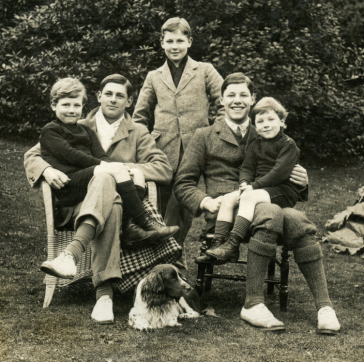
Dick (centre) with his brothers (from left to right) William, James, Henry and Edward. About 1913.
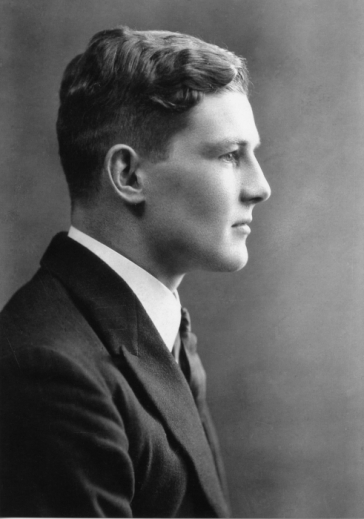
Dick in about 1917, just before he went off to the war
It was at this time that he won his Military Cross - the citation reads: “For conspicuous gallantry and devotion to duty. He established and maintained communication most successfully between units of a brigade under circumstances of peculiar difficulty, frequently under heavy rifle, machine-gun, and shell fire.”
A few weeks later, when the Germans broke through the Portuguese lines, the Highland
Division was called upon to re-establish the line. Dick had a clear memory from this phase
of the battle of reading Haig's "backs to the wall" message to his troops. “There is no other
course but to fight it out. Every position must be held to the last man: there must be no
retreat. With our backs to the wall, and believing in the justice of our cause, each one of
us must fight to the end, The safety of our homes and the freedom of mankind depends
on the conduct of each one of us at this critical moment.”
Once again, the situation was very fluid and one misty morning, he actually saw the
German cavalry, the redoubtable Uhlans, coming through. A few days later, at dawn, he
opened the barn door of his brigade HQ and walked straight into a prowling German
whose shot, fortunately, missed.
In October 1918, he was transferred back to the UK on a stretcher, mainly due to the
cumulative effect of exhaustion and phosgene gas poisoning: this was to affect his senses
of taste and smell for the remainder of his life.
In the 16 months between leaving school and being invalided back to the UK, he must have been through hell. His leadership and bravery was beyond doubt and as a result, at the end of the war, he was also awarded the Croix de Guerre.
After the war, Dick considered ordination but his Scottish pastor said to him, "Gammell, you will do more good outside the Church, than in". Though throughout his life he retained a close bond with the Church, having received this advice he decided to study Civil Engineering at University College London. He was a keen sportsman, playing cricket for the University team and scoring a very impressive 95 in the 1921 University match against the MCC. Playing Rugby for the University team and also at Roslyn Park, and running and throwing the hammer and shot for the University’s athletics team. In fact, he seems to have entered into collegiate life with a zest which was to characterise the rest of his life, being awarded the Fellows' Prize for the "greatest public service in reconstructing College and University life and activities since the Armistice." Not surprisingly perhaps, he failed to get his degree.
After University, he worked with Sir Alexander Gibb and Partners in Civil Engineering projects including a spell in Newfoundland. He played an important part in helping to keep vital services running during the 1926 General Strike which led to his recruitment by GWR with whom he worked as a Stores Inspector until 1929. During this period, he was an active rugby player with Rosslyn Park.
On 15 June 1926 he married Mary Turney Edwards in St Peters Church, Cranley Gardens, Kensington and they took up residence in Swindon, Wiltshire, where their first child, Guy Sydney Gammell, was born on 31 March 1927. On 23 August 1931 they had a daughter, Rosemary Stobart Gammell.
In about 1930, he joined ICI and lived in Edgbaston, Birmingham and Oxted, Surrey. During World War II he was based in London and it is reported that, on hearing the call for Home Guard Volunteers on the wireless, he ran to the recruiting office hoping to be the first to enlist.
Most of his career was spent working with the burgeoning plastics industry and his final appointment was as Northern Region Plastic Sales Manager, where his old-fashioned loyalty and integrity endeared him to customers and staff alike, whose trust he earned and retained.
Much to his chagrin he was required to take early retirement at the age of 58, and in 1956 went to live in the village of Thornford in Dorset. After a period of ill health and a failed attempt to grow chrysanthemums, for the next 35 years he devoted his phenomenal energies to local affairs. Paramount among these was the Church to which he rendered devoted service at parish, deanery and diocesan levels. He instituted a training scheme for Lay Pastors which continues to this day.
At the age of 87 he was the co-ordinator for the Church Urban Fund for the Sherborne Deanery and was responsible for raising over £21,000. For this achievement, he was invited to a reception at St James's Palace.
He led worship in local churches until his 92nd year. Mary died on 25 May 1991 and Dick on 9 November 1995.
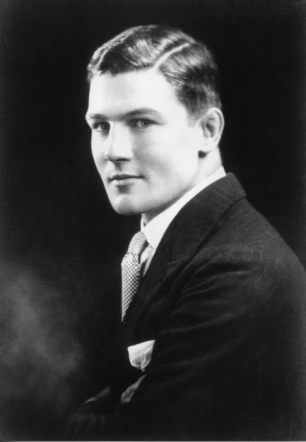
Dick in 1926, when he married Mary Edwards
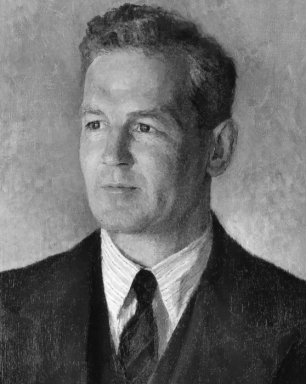
Portrait of Dick painted about 1950
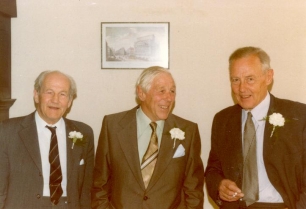
Dick (left) with his brothers Edward and William in 1978
